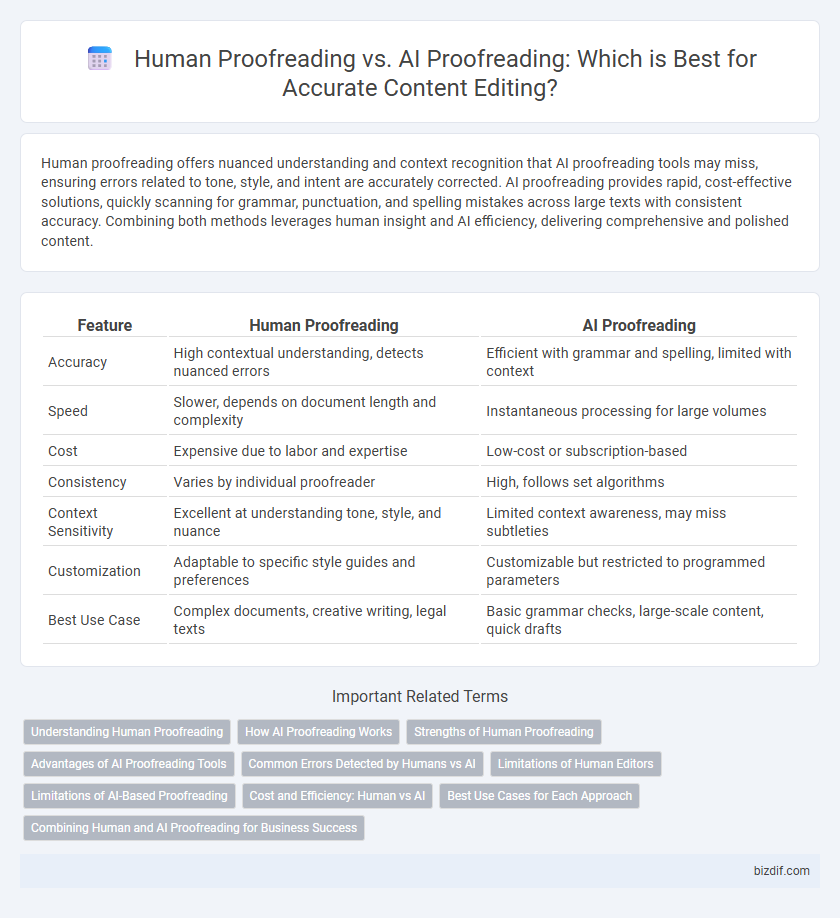Human proofreading offers nuanced understanding and context recognition that AI proofreading tools may miss, ensuring errors related to tone, style, and intent are accurately corrected. AI proofreading provides rapid, cost-effective solutions, quickly scanning for grammar, punctuation, and spelling mistakes across large texts with consistent accuracy. Combining both methods leverages human insight and AI efficiency, delivering comprehensive and polished content.
Table of Comparison
| Feature | Human Proofreading | AI Proofreading |
|---|---|---|
| Accuracy | High contextual understanding, detects nuanced errors | Efficient with grammar and spelling, limited with context |
| Speed | Slower, depends on document length and complexity | Instantaneous processing for large volumes |
| Cost | Expensive due to labor and expertise | Low-cost or subscription-based |
| Consistency | Varies by individual proofreader | High, follows set algorithms |
| Context Sensitivity | Excellent at understanding tone, style, and nuance | Limited context awareness, may miss subtleties |
| Customization | Adaptable to specific style guides and preferences | Customizable but restricted to programmed parameters |
| Best Use Case | Complex documents, creative writing, legal texts | Basic grammar checks, large-scale content, quick drafts |
Understanding Human Proofreading
Human proofreading offers nuanced error detection by leveraging contextual understanding and domain-specific knowledge that AI tools often miss. It excels in interpreting subtleties such as tone, style, and cultural references, ensuring the text aligns with intended communication goals. Skilled human proofreaders also adapt to complex language rules and ambiguous phrasing, providing personalized feedback beyond basic grammar and spelling corrections.
How AI Proofreading Works
AI proofreading works by leveraging advanced natural language processing algorithms to analyze text structure, grammar, and context. Machine learning models are trained on vast datasets, enabling AI to detect errors such as misspellings, punctuation mistakes, and syntactical inconsistencies with high accuracy. These systems continuously improve through iterative feedback, allowing for faster and scalable error detection compared to traditional human proofreading methods.
Strengths of Human Proofreading
Human proofreading excels in detecting context-sensitive errors, such as idiomatic expressions and nuanced tone, that AI often misses. Its ability to understand subtle cultural references and complex narrative structures ensures a more accurate and polished final text. Expert human proofreaders also provide creative suggestions for clarity and style improvement beyond mere grammatical corrections.
Advantages of AI Proofreading Tools
AI proofreading tools deliver rapid and consistent error detection across extensive texts, significantly enhancing editing efficiency. Advanced natural language processing algorithms enable these tools to identify complex grammatical structures, spelling errors, and stylistic inconsistencies with high accuracy. Integration with writing platforms allows real-time suggestions, facilitating seamless workflow and continuous improvement for users.
Common Errors Detected by Humans vs AI
Human proofreading excels at detecting contextual errors, nuanced tone inconsistencies, and subtle idiomatic expressions that AI often overlooks, especially in complex narrative texts. AI proofreading efficiently identifies spelling mistakes, basic grammatical errors, and punctuation flaws with high speed and consistency but may miss sarcasm, cultural references, or ambiguous phrasing. Combining human insight with AI's pattern recognition creates a comprehensive error-detection process that maximizes accuracy and readability.
Limitations of Human Editors
Human proofreading is limited by fatigue and subjective bias, leading to inconsistent error detection and slower turnaround times. Editors may overlook subtle grammatical nuances or context-specific errors due to cognitive overload or lack of specialized knowledge. These limitations highlight challenges in maintaining uniform quality and efficiency in large-scale or technical proofreading tasks.
Limitations of AI-Based Proofreading
AI-based proofreading often struggles with understanding complex contextual nuances and idiomatic expressions, leading to incorrect corrections or overlooked errors. It frequently fails to detect subtle tone inconsistencies or stylistic preferences that a human proofreader can easily identify. Dependence on algorithms also limits AI's ability to adapt to diverse writing styles and emerging language trends.
Cost and Efficiency: Human vs AI
Human proofreading typically involves higher costs due to skilled labor and longer turnaround times, while AI proofreading offers faster results at a fraction of the cost by processing large volumes of text instantly. Efficiency in human proofreading shines in nuanced understanding and context-sensitive corrections, which AI tools may miss despite their speed. Combining AI proofreading with human review can optimize cost-effectiveness by balancing rapid processing with expert accuracy.
Best Use Cases for Each Approach
Human proofreading excels in detecting nuanced language errors, cultural references, and context-specific meanings that AI proofreading tools might overlook, making it ideal for literary works, academic papers, and sensitive business communications. AI proofreading offers rapid, consistent, and cost-effective error detection for large volumes of content such as web articles, marketing copy, and technical documents, where speed and scalability are critical. Combining human expertise with AI efficiency often yields the highest accuracy in complex content requiring both precision and contextual understanding.
Combining Human and AI Proofreading for Business Success
Combining human proofreading with AI proofreading enhances accuracy and efficiency in business communication by leveraging the strengths of both methods. Human proofreaders provide nuanced understanding of context, tone, and style, while AI tools rapidly identify grammatical errors and inconsistencies. This hybrid approach ensures polished, error-free content that maintains brand voice and boosts professional credibility.
Human Proofreading vs AI Proofreading Infographic

 bizdif.com
bizdif.com